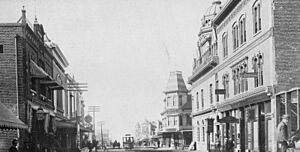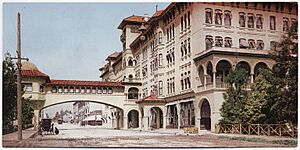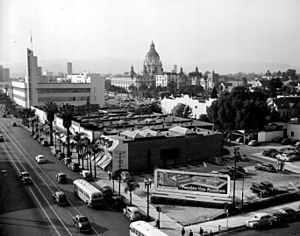History of Pasadena, California facts for kids
| Historical population | |||
|---|---|---|---|
| Census | Pop. | %± | |
| 1880 | 391 | — | |
| 1890 | 4,882 | 1,148.6% | |
| 1900 | 9,117 | 86.7% | |
| 1910 | 30,291 | 232.2% | |
| 1920 | 45,354 | 49.7% | |
| 1930 | 76,086 | 67.8% | |
| 1940 | 81,864 | 7.6% | |
| 1950 | 104,577 | 27.7% | |
| 1960 | 116,407 | 11.3% | |
| 1970 | 112,951 | −3.0% | |
| 1980 | 118,072 | 4.5% | |
| 1990 | 131,591 | 11.4% | |
| 2000 | 133,936 | 1.8% | |
Pasadena is a lively city in Los Angeles County, California. It was founded in 1874 and became an official city in 1886. Pasadena is well-known for its exciting history and for hosting two big events: the Tournament of Roses Parade (since 1890) and the yearly Rose Bowl game football game (since 1902). It is also home to important places like the California Institute of Technology (Caltech) and the Jet Propulsion Laboratory (JPL).
Contents
Pasadena's First People: The Tongva Tribe
Before Europeans arrived, the land where Pasadena now stands was home to the Hahamog-na tribe. These Native American people were part of the larger Tongva Nation. They spoke the Tongva language, which is part of the Uto-Aztecan languages family. The Tongva people had lived in the Los Angeles Basin for thousands of years.
Life Along the Arroyo Seco
Tongva homes, which were dome-shaped lodges made of thatch, were built along the Arroyo Seco (Los Angeles County). This area is now part of Pasadena. They also lived along other natural waterways in the city. Their diet included acorn meal, seeds, herbs, deer, and other small animals. They traded with coastal Tongva groups to get ocean fish. They even made cooking pots from soapstone found on Catalina Island.
Ancient Trails Still Used Today
The oldest transportation path still in Pasadena is an old Tongva foot trail. It's also known as the Gabrielino Trail. This trail runs along the west side of the Rose Bowl and up the Arroyo Seco. It continues past the Jet Propulsion Laboratory and into the San Gabriel Mountains. This trail has been used continuously for thousands of years. Another part of the trail is still used today in what is called Salvia Canyon. When the Spanish came, they built the San Gabriel Mission. They renamed the local Tongva people "Gabrielino Indians" after the mission. Today, several groups of Tongva people still live in the Los Angeles area.
How Pasadena Began: Early Development
Pasadena's land was originally part of a large Mexican land grant. This grant was called Rancho del Rincon de San Pascual. It was given on Easter Sunday to Eulalia Perez de Guillén Mariné from Mission San Gabriel Arcángel. The Rancho included the lands of today's Pasadena, Altadena, and South Pasadena.
First Settlers and Land Sales
Before California became part of the United States in 1848, the last Mexican owner was Manuel Garfias. He kept the land after California became a state in 1850. Garfias sold parts of the property to the first American settlers. These included Benjamin S. Eaton and Dr. S. Griffin. Much of the land was bought by Benjamin Davis Wilson. He started his Lake Vineyard property nearby. Wilson, known as Don Benito to the local Native Americans, was also the mayor of Los Angeles. Mount Wilson is named after him.
The Indiana Colony is Formed
In 1873, Dr. Daniel M. Berry from Indiana visited Wilson. Dr. Berry was looking for a place with a better climate for his patients. He had asthma and found that he slept very well at Rancho San Pascual. To keep this discovery a secret, Berry called the area "Muscat," after the grapes Wilson grew. To get money to bring people to San Pascual, Berry started the Southern California Orange and Citrus Growers Association. He sold shares in this company.
The new settlers bought a large part of the land along the Arroyo Seco. On January 31, 1874, they officially formed the Indiana Colony. As a kind gesture, Wilson added 2,000 acres (8 km2) of his highland property, which was not very useful then. Part of this land later became Altadena.
Merging Two Settlements
The Indiana Colony was a narrow strip of land between the Arroyo Seco and Fair Oaks Avenue. On the other side of the street was Wilson's Lake Vineyard development. For more than ten years, both areas grew side by side. Eventually, the two settlements joined together to form the City of Pasadena.
How Pasadena Got Its Name
Before the 1890s, mail for the Indiana Colony came through Los Angeles. To get their own post office, the Colony needed to change its name. The Postmaster General had to approve the new name. The town leaders voted on three names. The first was "Indianola," and the second was "Granada," to honor the area's Spanish history.
The third name came from Dr. Thomas Elliott. He asked a missionary friend in Michigan, who worked with the Minnesota Chippewa Native Americans, for help. Even though the Chippewa language was not from Southern California, Dr. Elliott submitted four phrases for translation. These were "Crown of the Valley," "Key of the Valley," "Valley of the Valley," and "Hill of the Valley." All the translations ended with "pa-sa-de-na," which meant "of the valley."
Because it sounded nice, "Pasadena" was chosen, voted on, and accepted. Maps from 1878 already showed both "Indiana Colony" and "Pasadena" in the same spot. In March 1886, Pasadena became the second city in Los Angeles County to be officially incorporated, after Los Angeles itself.
Pasadena: A Popular Resort Town (1886–1941)
Pasadena's pleasant climate attracted people from all over the country. The city became a stop on the Atchison, Topeka and Santa Fe Railway, which led to a huge increase in growth. Many houses built during this time are now on the National Register of Historic Places.
A Winter Getaway for the Wealthy
From the real estate boom of the 1880s until the Great Depression, Pasadena was a winter resort for wealthy people from the Eastern United States. This led to the creation of new neighborhoods and business areas. Roads and transit connections with Los Angeles also improved. This growth ended with the opening of the Arroyo Seco Parkway, California's first freeway. By 1940, Pasadena was the eighth largest city in California. Many people thought of it as a twin city to Los Angeles.
Grand Hotels of Pasadena
The first grand hotel in Pasadena was the Raymond (1886). It was built on Bacon Hill, which was renamed Raymond Hill. The original 200-room Victorian hotel burned down in 1895. It was rebuilt in 1903 but later torn down during the Great Depression for homes. The Maryland Hotel, built in the early 1900s, was demolished in 1937. The famous Mount Lowe Railway and its mountain hotels closed due to fire damage.
Three hotel buildings from that era still exist today:
- The Green Hotel, which became a co-op in 1926.
- The Vista Del Arroyo, now used as a Federal courthouse.
- A residential tower of the Maryland at 80 North Euclid Avenue, which became a co-op in 1953.
The Hotel Green
Construction on the Hotel Green began in 1887. Colonel George Gill Green, a rich businessman, finished the six-story building in 1888. In 1898, he built a second building across the street. He connected the two buildings with a bridge and a tunnel. Hotel guests arrived by train at the nearby station. In 1902, the hotel expanded again. In 1924, it became a private residence. The original 1888 building was later partly torn down and sold. Today, it houses STATS Floral Supply. In 1970, the remaining hotel wings were separated into two buildings. The 1898 section is now a private residence called the Castle Green. The 1902 part became a government-supported housing for seniors and disabled people, called the Green Hotel.
The Vista Del Arroyo Hotel
The Vista Del Arroyo Hotel on Grand Avenue was used by the Navy as a hospital during World War II. It was called McCormack General Hospital. Today, the United States Court of Appeals for the Ninth Circuit is located in the fully restored former hotel. The Royce Family, who also owned the Royal Hawaiian Hotel and the Huntington Hotel, once owned this hotel.
Grand Avenue's Famous Residents
Grand Avenue is a historic street lined with large estates. Over time, it was home to many important people. These included Jared Torrance, who founded the City of Torrance, and J.B. Van Nuys, who founded the City of Van Nuys. The Cox family, famous for communications and newspapers, and the Spalding family, who were sporting goods leaders, also lived there. Howard Huntington, heir to Henry E. Huntington, was another resident.
Transportation in Pasadena
Trains Connect Pasadena
Pasadena was served by the Atchison, Topeka and Santa Fe Railway. The Santa Fe Depot in downtown opened in 1887. In 1925, a beautiful, traditional-style station opened in Pasadena. This train line was very important for businesses in the San Gabriel Valley. However, longer freight trains had trouble climbing the steep hill between Pasadena and Los Angeles. This made operations more expensive. A new, more efficient line opened in 1888 and took over most of the longer freight trains.
The Pasadena Depot became well-known for the many passenger trains that passed through it. Up to 26 passenger trains went through Pasadena every day. Many celebrities chose to use Pasadena as their main train station to avoid the media in Los Angeles. This gave the station a glamorous feel from old Hollywood.
Pasadena's Craftsman Era (1890s–1930s)
The American Craftsman style of art and design is very visible in Pasadena. The architectural firm of Greene and Greene, the Green Brothers, developed this style. Many of their homes still exist today. Two famous examples of their "Ultimate bungalow" designs are the amazing Gamble House (which you can tour) and the Robert R. Blacker House (a private home). Both are recognized as California Historical Landmarks and are on the U.S. National Register of Historic Places.
Busch Gardens: A Former Attraction
Adolphus Busch was a co-founder of Anheuser-Busch, the company that makes Budweiser beer. He was a wealthy man from the East who loved Pasadena's mild climate. He created the first of his Busch Gardens here. The first Busch Gardens opened in 1905 and closed to the public in 1937. During its time, it was a major tourist attraction in the Los Angeles area. It featured unique gardens, fairyland landscapes, and structures. It was even used as a filming location for several Hollywood movies. After 1937 and World War II, much of the land was used to build homes. When Busch died at his Pasadena estate, his wife offered the home to the City of Pasadena, but the city declined. If you look closely today, you can still see many of the original river rock walls and structures from the gardens.
Pasadena During and After World War II (1941–1969)
World War II brought a big boost to Pasadena. Southern California became an important area for preparing for the Pacific War. High-tech manufacturing and scientific companies moved to the city. This trend continued after the war, with places like NASA's Jet Propulsion Laboratory, Tetra Tech, and Ameron International making Pasadena their home.
In the 1950s, many people from the Southern United States, especially African-Americans from Texas and Louisiana, moved to Pasadena. The city also began to welcome a large number of immigrants, particularly from Guatemala, El Salvador, and Armenia.
Pasadena Since 1970
The American Academy of Dramatic Arts, founded in New York in 1884, opened its Pasadena campus in 1974. However, in 2001, this acting school moved to Hollywood. It was the first school in the United States to offer professional acting training. Point Loma Nazarene University was also located in Pasadena for many years before moving to San Diego County. It was known as both Pasadena University and Pasadena College.
Changes and Challenges
In 1969, the Pasadena Unified School District began to desegregate its schools. This issue continued to be debated in court for another decade. A year later, the 210 Freeway was built. Its construction was controversial because it led to the demolition of over a thousand homes, many of them historic. Some people believed the freeway's path was chosen to cut through the city's less wealthy neighborhoods.
The situation in Pasadena became difficult. Downtown Pasadena became unsafe in some areas and empty in others. Crime rates increased. Old Pasadena was almost destroyed by plans for new tall buildings. However, people who wanted to protect historic buildings became more active and mostly stopped these plans. Many residents moved to nearby suburbs or the Inland Empire, causing Pasadena's population to shrink. Despite these problems, many local artists and creative people moved in to take advantage of lower property prices. Their influence can still be seen today in the Doo Dah Parade, which started in 1976.
The 1970s also saw a rise in gang violence in Pasadena. This led the Pasadena Police Department to take stronger action against gang activity, and the violence decreased in the mid-1990s.
Pasadena's Revival
In the early 2000s, several projects began to make the city more beautiful. Many neighborhoods that were once poor started to improve. In 2003, the Los Angeles County Metro's Gold Line opened. This brought rail public transportation back to Pasadena for the first time since 1951. New apartment buildings began to appear in the main business areas, leading to a big increase in population.
Pasadena's growth slowed down during the late 2000s Recession. However, important safety work was completed on the City Hall building in summer 2007. It had been closed in July 2004 due to safety concerns, and construction started in March 2005.
On November 8, 2022, Pasadena voters approved Ballot Measure H. This measure passed with 54 percent of the vote. It will create a Rental Board appointed by the City Council. Seven residents, who live in each of the seven City Council districts and are renters, will be chosen by the Council. Ballot Measure H was supported by the city's renters union and the Pasadena Unified School District's Board of Education, superintendent, and school principals. Many renters have lived in the city for many years.





